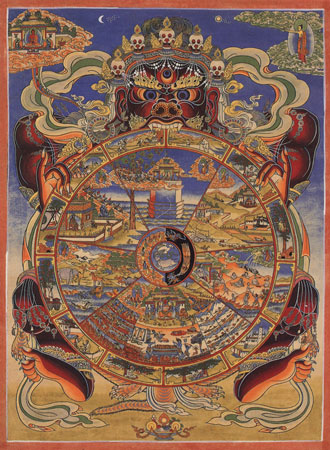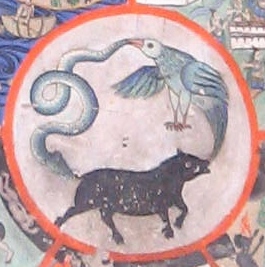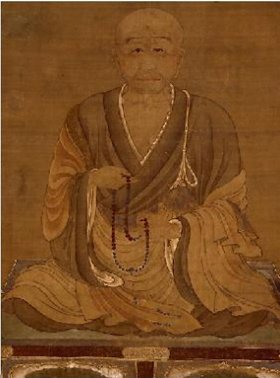|
Six Paths
The Six Paths in Buddhist cosmology. the six worlds where sentient beings are reincarnated according to their karmas linked to their acts of previous lives. They are represented pictorially in the form of the Bhavacakra ("wheel of existence")."). these are: # the world of gods or celestial beings (deva) ; # the world of warlike demigods (asura) ; # the world of human beings (manushya) ; # the world of animals ( tiryagyoni) ; # the world of the starving (preta) ; # the world of Hell (naraka). The first three are called "the three benevolent destinies" (kuśalagati), where beings are more or less virtuous, there is pleasure and there is pain, and the last three are called the three unbenevolent destinies (akuśalagati), where beings lack virtue, there is almost only suffering. We human beings normally only see the animals besides ourselves. The first Buddhist texts mention only five paths, not differentiating between the paths of the devas and the asuras. In Japan, the monk Genshin e ... [...More Info...] [...Related Items...] OR: [Wikipedia] [Google] [Baidu] |
Bhavachakra
The bhavacakra (Sanskrit: भवचक्र; Pāli: ''bhavacakka''; Tibetan: སྲིད་པའི་འཁོར་ལོ, Wylie: ''srid pa'i 'khor lo'') is a symbolic representation of saṃsāra (or cyclic existence). It is found on the outside walls of Tibetan Buddhist temples and monasteries in the Indo-Tibetan region, to help non Buddhists understand Buddhist teachings. It is used in Indian Buddhism and Tibetan Buddhism. Etymology ''Bhavachakra'', "wheel of life," consists of the words ''bhava'' and ''cakra''. ''bhava'' () means "being, worldly existence, becoming, birth, being, production, origin".Monier Monier-Williams (1899), Sanskrit English Dictionary, Oxford University Press, Archiveभव bhava In Buddhism, ''bhava'' denotes the continuity of becoming (reincarnating) in one of the realms of existence, in the samsaric context of rebirth, life and the maturation arising therefrom. It is the tenth of the Twelve Nidanas, in its ''Pratītyasamutpāda'' doctrine. ... [...More Info...] [...Related Items...] OR: [Wikipedia] [Google] [Baidu] |
Preta
Preta ( sa, प्रेत, bo, ཡི་དྭགས་ ''yi dags''), also known as hungry ghost, is the Sanskrit name for a type of supernatural being described in Hinduism, Buddhism, Taoism, and Chinese folk religion as undergoing suffering greater than that of humans, particularly an extreme level of hunger and thirst. They have their origins in Indian religions and have been adopted into East Asian religions via the spread of Buddhism. Preta is often translated into English as "hungry ghost" from the Chinese and East Asian adaptations. In early sources such as the ''Petavatthu'', they are much more varied. The descriptions below apply mainly in this narrower context. The development of the concept of the preta started with just thinking that it was the soul and ghost of a person once they died, but later the concept developed into a transient state between death and obtaining karmic reincarnation in accordance with the person's fate. In order to pass into the cycle of ka ... [...More Info...] [...Related Items...] OR: [Wikipedia] [Google] [Baidu] |
Sanskrit Words And Phrases
Sanskrit (; attributively , ; nominally , , ) is a classical language belonging to the Indo-Aryan branch of the Indo-European languages. It arose in South Asia after its predecessor languages had diffused there from the northwest in the late Bronze Age. Sanskrit is the sacred language of Hinduism, the language of classical Hindu philosophy, and of historical texts of Buddhism and Jainism. It was a link language in ancient and medieval South Asia, and upon transmission of Hindu and Buddhist culture to Southeast Asia, East Asia and Central Asia in the early medieval era, it became a language of religion and high culture, and of the political elites in some of these regions. As a result, Sanskrit had a lasting impact on the languages of South Asia, Southeast Asia and East Asia, especially in their formal and learned vocabularies. Sanskrit generally connotes several Old Indo-Aryan language varieties. The most archaic of these is the Vedic Sanskrit found in the Rig Veda, a collec ... [...More Info...] [...Related Items...] OR: [Wikipedia] [Google] [Baidu] |
Avidyā (Buddhism)
Avidyā (Sanskrit: अविद्या; Pāli: अविज्जा, ''Avijjā''; Tibetan phonetic: ''ma rigpa'') in Buddhist literature is commonly translated as "ignorance". The concept refers to ignorance or misconceptions about the nature of metaphysical reality, in particular about the impermanence and '' anatta'' doctrines about reality. It is the root cause of '' Dukkha'' (suffering, pain, unsatisfactoriness), and asserted as the first link, in Buddhist phenomenology, of a process that leads to repeated birth. Avidyā is mentioned within the Buddhist teachings as ignorance or misunderstanding in various contexts: * Four Noble Truths *_The_first_link_in_the_twelve_links_of_dependent_origination *_One_of_the_three_poisons_within_the_Mahayana_Buddhist_tradition *_One_of_the_Mental_factors_(Buddhism)#Six_root_unwholesome_factors.html" ;"title="Four Noble Truths: BUDDHIST PHILOSOPHY Encycl ... * The first link in the twelve links of dependent origination * One of the three ... [...More Info...] [...Related Items...] OR: [Wikipedia] [Google] [Baidu] |
Three Poisons
The three poisons (Sanskrit: ''triviṣa''; Tibetan: ''dug gsum'') or the three unwholesome roots (Sanskrit: ''akuśala-mūla''; Pāli: ''akusala-mūla''), in Buddhism, refer to the three root kleshas: '' Moha'' (delusion, confusion), ''Raga'' (greed, sensual attachment), and ''Dvesha'' (aversion, hate). These three poisons are considered to be three afflictions or character flaws innate in a being, the root of ''Taṇhā'' (craving), and thus in part the cause of '' Dukkha'' (suffering, pain, unsatisfactoriness) and rebirths. The three poisons are symbolically drawn at the center of Buddhist ''Bhavachakra'' artwork, with rooster, snake, and pig, representing greed, ill will, and delusion respectively. Brief description In the Buddhist teachings, the three poisons (of ignorance, attachment, and aversion) are the primary causes that keep sentient beings trapped in samsara. These three poisons are said to be the root of all of the other kleshas. The three poisons are represente ... [...More Info...] [...Related Items...] OR: [Wikipedia] [Google] [Baidu] |
Skandha
(Sanskrit) or (Pāḷi) means "heaps, aggregates, collections, groupings". In Buddhism, it refers to the five aggregates of clinging (), the five material and mental factors that take part in the rise of craving and clinging. They are also explained as the five factors that constitute and explain a sentient being’s person and personality, but this is a later interpretation in response to sarvastivadin essentialism. The five aggregates or heaps of clinging are: # form (or material image, impression) () # sensations (or feelings, received from form) () # perceptions () # mental activity or formations () # consciousness (). In the Theravada tradition, suffering arises when one identifies with or clings to the aggregates. This suffering is extinguished by relinquishing attachments to aggregates. The Mahayana tradition asserts that the nature of all aggregates is intrinsically empty of independent existence. Etymology () is a Sanskrit word that means "multitude, quantit ... [...More Info...] [...Related Items...] OR: [Wikipedia] [Google] [Baidu] |
Pudgala
In Jainism, Pudgala (or ') is one of the six Dravyas, or aspects of reality that fabricate the world we live in. The six ''dravya''s include the jiva and the fivefold divisions of ajiva (non-living) category: ''dharma'' (motion), ''adharma'' (rest), ''akasha'' (space), ''pudgala'' (matter) and ''kala'' (time). ''Pudgala'', like other ''dravya''s except ''kala'' is called ''astikaya'' in the sense that it occupies space. Pudgala is derived from the words 'pud', which is defined as Supplement (Addition /Fusion), and gala, which is defined as Disintegrate, or Division or Fission. Therefore, Pudgalas are best defined as all things that are continuously changing by the process of Supplementation or Disintegration, namely matter. The individual unit of Pudgala is the material from which all is made called a Paramanu, which, by the process of supplementation, can combine to form what can be roughly said is an aggregate, called a Skandha. It possesses at all times four qualities, na ... [...More Info...] [...Related Items...] OR: [Wikipedia] [Google] [Baidu] |
Genshin
, also known as , was the most influential of a number of scholar-monks of the Buddhist Tendai sect active during the tenth and eleventh centuries in Japan. Genshin, who was trained in both esoteric and exoteric teachings, wrote a number of treatises pertaining to the increasingly popular Pure Land Buddhism from a Tendai viewpoint, but his magnum opus, the , had considerable influence on later Pure Land teachers such as Honen and Shinran. In spite of growing political tensions within the Tendai religious hierarchy, and despite being one of the two leading disciples of the controversial Ryogen, 18th head of the Enryakuji Temple, Genshin and a small group of fellow monks maintained a secluded community at Yokawa on Mount Hiei solely devoted toward rebirth in the Pure Land, while staying largely neutral in the conflict. He was one of the thinkers who maintained that the nembutsu ritual, which was said to induce a vision of Amida, was an important hermeneutic principle in the Bu ... [...More Info...] [...Related Items...] OR: [Wikipedia] [Google] [Baidu] |
Naraka
Naraka ( sa, नरक) is the realm of hell in Indian religions. According to some schools of Hinduism, Sikhism, Jainism and Buddhism, ''Naraka'' is a place of torment. The word ''Neraka'' (modification of ''Naraka'') in Indonesian and Malaysian has also been used to describe the Islamic concept of Hell. Alternatively, the "hellish beings" that are said to reside in this underworld are often referred to as ''Narakas''. These beings are also termed in Sanskrit as ''Narakiyas'' ( sa, नारकीय, ), ''Narakarnavas'' ( sa, नरकार्णव, ) and ''Narakavasis'' ( sa, नरकवासी, ). Hinduism Naraka is a realm in the Vedas, a place where souls are sent for the expiation of their sins. It is mentioned primarily in the Dharmashastras, Itihasas, and the Puranas, but also described in the Vedic samhitas, the Aranyakas and the Upanishads. Some Upanishads speak of 'darkness' instead of hell. A summary of the Upanishads and the Bhagavad Gita mentions hell ... [...More Info...] [...Related Items...] OR: [Wikipedia] [Google] [Baidu] |
Buddhist Cosmology
Buddhist cosmology describes the planes and realms in which beings can be reborn. The spatial cosmology consists of a vertical cosmology, the various planes of beings, into which beings are reborn due to their merits and development; and a horizontal cosmology, the distribution of these world-systems into an "apparently" infinite sheet of "worlds." The temporal cosmology describes the timespan of the creation and dissolvement of universes in aeons. Buddhist cosmology is also intwined with the belief of karma, and explains that the world around us is the product of past actions. As a result, some ages are filled with prosperity and peace due to common goodness, whereas other eras are filled with suffering, dishonesty and short lifespans. Meaning and origin Course of rebirth and liberation The Buddhist cosmology is not a literal description of the shape of the universe; rather, it is the universe as seen through the (Pāli: dibbacakkhu दिब्बचक्खु), the "div ... [...More Info...] [...Related Items...] OR: [Wikipedia] [Google] [Baidu] |
Human Beings In Buddhism
Humans in Buddhism (, , Pali ) are the subjects of an extensive commentarial literature that examines the nature and qualities of a human life from the point of view of humans' ability to achieve enlightenment. In Buddhism, humans are just one type of sentient being, that is a being with a mindstream. In Sanskrit Manushya means an Animal with a mind. In Sanskrit the word Manusmriti associated with Manushya was used to describe knowledge through memory. The word Muun or Maan means mind. Mind is collection of past experience with an ability of memory or smriti. Mind is considered as an animal with a disease that departs a soul from its universal enlightened infinitesimal behavior to the finite miserable fearful behavior that fluctuates between the state of heaven and hell before it is extinguished back to its infinitesimal behavior. In Enlightenment as an arhat can be attained from the realms of the Śuddhāvāsa deities. A bodhisattva can appear in many different types of liv ... [...More Info...] [...Related Items...] OR: [Wikipedia] [Google] [Baidu] |






